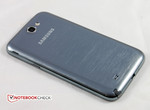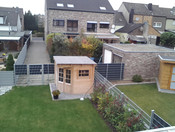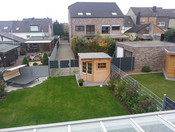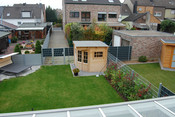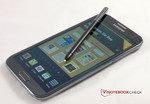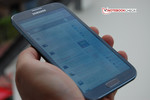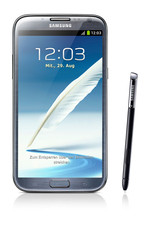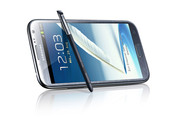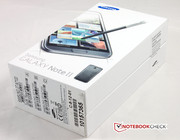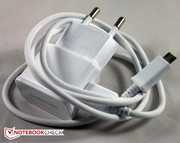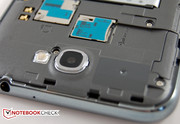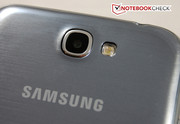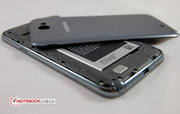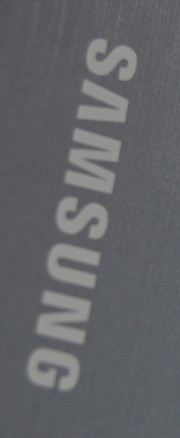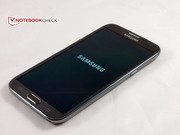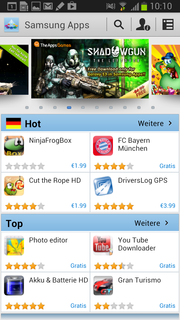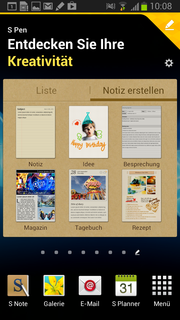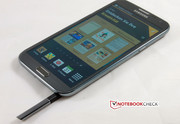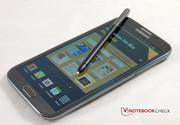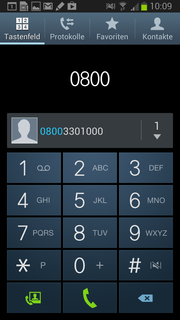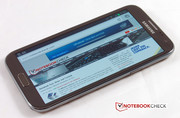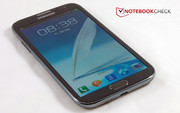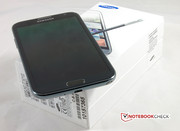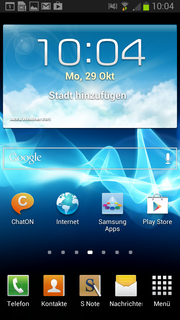Review Samsung Galaxy Note II GT-N7100 Smartphone

Manufacturers like Samsung, who offer a large variety of products, can also fill niches. And the Korean manufacturer does this constantly. No matter if it is a smartphone with an integrated LED projector or a robust device for outdoor use. And while Apple flaunts the "new size" of its iPhone 5, Samsung has had tablets and smartphones of all sizes in its array.
Many jaws dropped – and we were no exception - as the first Galaxy Note was launched because of its unusual size. Many thought the 5.3 inch screen was too big for a smartphone but too small for a tablet. Thus it is no surprise that our review at the beginning of this year started with the words "Smartphone or Tablet". However, the new intermediate size ultimately achieved a very good final rating and convinced in virtually every test. We merely criticized the limited mobility and the high price.
The recently released Samsung Galaxy Note II, product code GT-N7100, now follows in the quite successful footsteps of the precursor Note and - how can it be different - is a bit bigger. The screen diagonal is 5.55 inches but the aspect ratio has been reduced from 16:10 to 16:9 so that the "smartlet" is merely longer. Its width has even decreased by about five millimeters (~0.20 inches).
Nevertheless, the changes in appearance are very moderate. It is primarily the innards that have been refreshed. And here, Samsung has really got something to offer: a quad-core processor from its own production, two GB of memory and the latest Android 4.1 operating system, aka Jelly Bean. Its big brother, the Galaxy Note 10.1, featuring almost the same equipment already caused a stir with its outstanding performance at Notebookcheck.
The recommended price has not changed. It is still 699 Euros (~$897). That is more than steep for a device sporting a 16 GB memory. Fortunately, the street prices are considerably below this.
Case
As surprised as we were about the first Galaxy Note's dimensions, the Note II no longer appears to be as extreme in view of the increasing size of smartphones. Nevertheless, it has a special status due to its 5.55 inch screen. But Samsung has done well to reduce the aspect ratio to 16:9. The new Note is now more comfortable to hold than the first edition.
The workmanship is again high-standard. The choice of materials, however, does not quite do justice to such a high-end smartphone. Plastic dominates most of the casing. In return, the metal-like battery lid looks more elegant than the precursor's. But it lacks stability, though only noticed when opening it. Although the aluminum lid is plainly very thin, there is no need to fear that it will break since it is hardly ever opened.
Compared with its precursor, the Note II is a good four millimeters (~0.16 inches) longer but also five millimeters (~0.20 inches) narrower. We would not call it a fragile phone though. We would rather say it is a bit handier. Four grams of added weight is tolerable. Samsung's Galaxy Note II has a lightweight feel to it despite weighing 182 grams (~0.4 pounds). The size likely belies the real weight in this case.
All other observations we made with the casing are consistent with the experiences we made with the precursor. We still think that there is a better solution for the micro SD card slot located underneath the battery compartment.
As in all Note models, the mandatory stylus called S Pen is also inserted in the Note II. It is now longer and thicker, which is to facilitate use. It is inserted in the casing's lower right corner.
Connectivity
Apparently Samsung applies the motto "the more the better" in connectivity. The Korean manufacturer's Note family is known for this. The smartlet follows its tablet brother, Note 10.1, and features the SoC (system-on-a-chip) as its core piece. Its high performance already impressed us at the time. Samsung goes a step further with its "small" Note II. Samsung's own Exynos 4412 quad-core processor already belongs to the fastest tablet and smartphone SoCs. But Samsung does not clock it with "only" 1.4 GHz like in the Note 10.1". The four cores work with 1.6 GHz in the Note II. Moreover, a quad-core graphics unit called ARM Mali-400 MP4 is on the chip, which is certainly not weak. Samsung supports the CPU with generous two GB of working memory and thus outdoes most high-end competitors.
Samsung is as economic as always when it comes to the internal memory capacity. 16 GB sounds scanty in view of the steep price - even if the Korean manufacturer repeatedly emphasizes that extending it via a micro SD card would be fast and cheap.
The Note II does not feature many buttons or ports. The volume rocker and power button positioning, both in the upper left and right side in profile mode, unfortunately caused us to trigger them unintentionally. However, most users will likely use the device in landscape mode because of its size. There is a multipurpose port at the bottom and a headphone jack at the top.
Software
Following Google's Nexus 7, Samsung's Galaxy Note II is the second Android device we have reviewed that features Google's latest operating system called Jelly Bean. All other smartphones and tablets came with the prior version, Ice Cream Sandwich, even after Android 4.1 was released. After all, it was only a minor release. The optimizations compared to Android 4.0 are not minor. For example, Google has put a lot of effort into making routine use very comfortable and consistent. Google speaks of a "fast" user experience. Moreover, functions like Google Now, which is to facilitate organizing your day, have been added. Other important alterations are incremental app updates and the greater involvement of hardware manufacturers in the development of Google's OS. The updates are supposed to be distributed even faster to the customers.
One feature of Samsung's Note devices is the S apps optimized for stylus inputs. We described the functionality of the S Pen in the reviews of the precursor and the big brother, Galaxy Note 10.1, in detail.
Interestingly, Samsung again neither uses its proprietary icon for making screenshots nor the native function from Android Jelly Bean (via power and volume down). Instead the user has to press the power and home button at the same time. The S Pen also has a screenshot function.
Communication & GPS
As appropriate for a modern smartphone of the premium class, Samsung's Galaxy Note II features all important communication interfaces. It is exemplary that the Wi-Fi module also transmits on the wider 5 GHz band. Bluetooth V4.0 is also up-to-date. On the go, the Note II communicates via the fast HSPA+ standard with up to 21 MBit/s in download and a maximum of 5.76 MBit/s in upload. In view of the steep price, an LTE module should also be installed in our opinion: If not because of the theoretically higher data rates, than at least in order to have a state-of-the-art device in your hands.
Naturally, Samsung's smartlet also includes a GPS sensor. Its functionality and accuracy are excellent.
Cameras & Multimedia
A smartphone without a camera? Unthinkable. According to Apple, most pictures uploaded to relevant photography sites are made with the iPhone 4S. The fact is smartphones are completely replacing the digital camera in many households, no matter if on vacation, at a party or simply in everyday situations. The smartphone camera is always available. However, there are still many downsides when it comes to the quality of smartphone cameras. But first the technical specs about the picture sensors in Samsung's Galaxy Note II. The Korean manufacturer installs a 1.9 megapixel front-facing camera lens in the upper right corner. The rear-facing camera has an up-to-date resolution of eight megapixels and features an LED flash.
The front-facing camera is at most suitable for video calls. Pictures are very blurry and pale. On the other hand, the rear-facing camera shoots usable pictures in bright ambient light. The focus is good, but colors are a bit too pale here as well. We noticed an intense noise in poor ambient light. The panorama feature, that provides compelling results even with a slightly shaky hand, is good. The camera takes videos in Full-HD. The colors are good and the sensor responds quickly to brightness changes.
Watching videos is really fun. The AMOLED screen really comes into its own here. Moreover the good speaker provides a good sound quality.
Accessories
Not much is found in the small, elegant-looking box of the Galaxy Note II. Besides the essential things like PSU and USB cords, a quick guide and warranty notes, there is a cabled, stereo in-ear headset with a remote. Furthermore, exchangeable silicon ear plugs in various sizes are found. Samsung lists several covers priced between 20 Euros (~$26) and 35 Euros (~$45) as optional accessories on its website. In addition to that, there is a multimedia docking station for 80 Euros (~$103), which adds three more USB ports, an HDMI and an audio jack. The S Pen replacement costs 30 Euros (~$39).
Warranty
The warranty period is 24 months. It does not include the battery, headset or charger and its USB cable. They are only covered for six months.
Games
As on the Galaxy Note 10.1, the Note II's graphics performance is more than sufficient for all up-to-date 3D games on paper. The practical test with games like Raging Thunder 2 and the third-person shooter ShadowGun confirm this. The games run absolutely smoothly and are a lot of fun on the big and extremely high-contrast screen. The controls via the accurate touchscreen and the well-working gyroscope contribute to gaming fun.
Input Devices & Controls
There is not much to say about the controls of Samsung's Galaxy Note II - and that is meant positively across the board. Apps open very fast, content rotates almost without delay and the touchscreen works perfectly. The Android controls also benefit from the very large size for a smartphone. The buttons of the virtual keyboard are agreeably large and enable fast and typo-free writing even in profile mode.
We already mentioned that we do not consider the position of the volume rocker and power button as ideal. And you can read that the S Pen works well and has quite a few advantages in the review of the Galaxy Note 10.1.
Display
The screen in Samsung's Galaxy Note II is big. Period. It has a diagonal of 5.55 inches and is thus 0.25 inches larger than its precursor. However, since the aspect ratio has been reduced from 16:10 to 16:9, the effective display surface is virtually unchanged. The narrower aspect ratio naturally has an impact on the resolution. Thus, the Note II no longer displays 1280x800 pixels, but rather the "lesser" HD resolution of 1280x720 pixels. Movie fans will be pleased about that because bars are not shown on HD videos anymore. This of course does not change anything about the slightly lower resolution.
Like in the smartphone flagship Galaxy S3, Samsung relies on a Super AMOLED screen from its own production in the new high-end smartlet. A good decision since the AMOLED technology stands for brilliant colors, saturated contrasts and absolute viewing angle stability.
Nevertheless, the Note II's screen is not completely convincing. The brightness assessment shows a maximum average brightness of a moderate 230 cd/m2. Many competitors do a better job here. Even the precursor displayed around 110 cd/m2 and was approximately 50 percent brighter. The illumination of 89 percent is not perfect either. However, brightness differences are not seen with the naked eye. The black value is zero because the pixels of black areas are simply not illuminated in an AMOLED screen. The contrast ratio cannot be evaluated because of this and is virtually infinite. The fact is the contrast is very high.
| |||||||||||||||||||||||||
Brightness Distribution: 89 %
Center on Battery: 223 cd/m²
Contrast: ∞:1 (Black: 0 cd/m²)
The subjective assessment of the picture quality confirms what the measurements already let us presume. The screen scores with brilliant colors and very saturated black hues. Pictures and movies benefit visibly from the high contrast. However, a typical weakness of AMOLED screens becomes obvious in light and white colors - a slight but always present bluish cast.
The Note II's screen makes a conflicting impression outdoors. AMOLED has a certain advantage over IPS screens, for example in backlit TFTs. But an AMOLED screen cannot perform magic either. It is noticed that the brightness is too low. Then there is the reflective glass surface that modern capacitive touchscreens simply involve. Nevertheless, Samsung's smartlet does quite a good job. The screen just cannot defy direct sunlight.
A typical specialty of organic LED screens is the viewing angle stability. Samsung's Galaxy Note II is (almost) no exception. The colors and brightness remain stable up into the narrowest angles. We reckoned with that. However, the bluish cast becomes more intense the flatter the viewing angles get. This mars the otherwise good impression a bit.
Performance
Uncompromising - that likely describes the CPU configuration of Samsung's Galaxy Note II best. With the proprietary quad-core Exynos 4412, the Korean manufacturer installs one of the currently strongest SoCs available in the smartphone and tablet sector. At the moment, the high clock speed of 1.6 GHz also makes any serious competitors unlikely. One exception would be Apple's A6 chip in the iPhone 5 that is to clearly outperform the graphics performance of the fourth generation iPad with the new A6X shortly. We will publish an online review in due time. But back to the Note II. A quad-core chip in the form of an ARM Mali-400 MP4 does the graphics work. With two GB of working memory, the Note II also has a clear lead here. It is obvious that Samsung wants to place its second smartlet in the premium class in view of these technical specs.
Our benchmark tests also clearly show that the Note II is currently one of the fastest devices among the smartphones and tablets that we reviewed until now. It places itself in the absolute premium sector, before its Galaxy S3 and Note 10.1 brothers, in all benchmarks. In fact, merely Apple's iPhone 5 can currently compete and partly even outperform it at the moment. Both high-end smartphones are neck and neck in the browser-based benchmarks Browsermark and Sunspider, whereby the iPhone has a minor advantage. In return, the Note II sets the standard in Geekbench. The I/O performance is also on a very high level, as the corresponding test of the AnTuTu benchmark proves. It also scores well in graphic-heavy tests like GL Benchmark 2.5 or Basemark. But it cannot compete with the iPhone 5's outstanding graphic performance. Nevertheless, Samsung has conjured up an extremely strong device with its Galaxy Note II.
| Browsermark 1.0 - --- (sort by value) | |
| Samsung Galaxy Note II GT-N7100 | |
| Samsung Galaxy Note 10.1 | |
| Samsung Galaxy S3 | |
| Apple iPhone 5 | |
| HTC One X | |
| Google Nexus 7 | |
| Sunspider - 0.9.1 Total Score (sort by value) | |
| Samsung Galaxy Note II GT-N7100 | |
| Samsung Galaxy Note 10.1 | |
| Samsung Galaxy S3 | |
| Apple iPhone 5 | |
| HTC One X | |
| Google Nexus 7 | |
| Geekbench 2 - 32 Bit - Total Score (sort by value) | |
| Samsung Galaxy Note II GT-N7100 | |
| Samsung Galaxy Note 10.1 | |
| Samsung Galaxy S3 | |
| Apple iPhone 5 | |
| HTC One X | |
| Google Nexus 7 | |
| GLBenchmark 2.5 - 1920x1080 Egypt HD Offscreen Fixed Time (sort by value) | |
| Samsung Galaxy Note II GT-N7100 | |
| Samsung Galaxy Note 10.1 | |
| Samsung Galaxy S3 | |
| Apple iPhone 5 | |
| Google Nexus 7 | |
| Basemark ES 2.0 - Taiji Free (sort by value) | |
| Samsung Galaxy Note II GT-N7100 | |
| Samsung Galaxy Note 10.1 | |
| Samsung Galaxy S3 | |
| HTC One X | |
| Google Nexus 7 | |
| Linpack Android / IOS - Multi Thread (sort by value) | |
| Samsung Galaxy Note II GT-N7100 | |
| Samsung Galaxy Note 10.1 | |
| Samsung Galaxy S3 | |
| Apple iPhone 5 | |
| HTC One X | |
| Google Nexus 7 | |
* ... smaller is better
Although a smartphone virtually replaces a personal assistant nowadays, phone calls are still one of its main applications. Using the telephone app is very comfortable and does not cause bewilderment. This application also benefits from the screen's size. The audio quality is good; the caller's voice is intelligible and sounds quite natural. Nevertheless it could still be a bit clearer. The reproduction sounds slightly muffled. The integrated speaker works well as a hands-free solution as long as you are in a quiet surrounding. For example, the small speaker is overtaxed while driving a car. The speech quality does not score as well on the calling partner's side, but is still acceptable for a cell phone. The voice clearly sounds more synthetic and slightly altered. Background noises, like wind or conversations, are sufficiently filtered.
Emissions
Temperature
This part of the Note II's review is short. The big smartphone only exceeded a lukewarm temperature during long-lasting load. We tested this with the Stability Test app. However, the temperatures always remained within an absolutely harmless range. Our infrared thermometer never climbed over 42.5 degrees Celsius (108.5 °F).
(±) The maximum temperature on the upper side is 42.5 °C / 109 F, compared to the average of 35.2 °C / 95 F, ranging from 21.9 to 247 °C for the class Smartphone.
(+) The bottom heats up to a maximum of 39.4 °C / 103 F, compared to the average of 34 °C / 93 F
(+) In idle usage, the average temperature for the upper side is 31.1 °C / 88 F, compared to the device average of 32.9 °C / 91 F.
Battery Life
Power Consumption
It was to be expected that the power consumption would be higher than that of the precursor, considering the much stronger CPU and GPU. Samsung counters this circumstance with a considerably larger battery. Rather than the previous 2500 mAh, the lithium ion battery now has a total capacity of 11.78 Wh or 3100 mAh. That should ensure a long battery runtime, especially since the power appetite is still moderate. The idle power consumption ranges from 0.5 to 1.5 Watts, which are excellent rates. The power consumption naturally increases during full load. However, our multimeter never recorded more than six Watts.
| Off / Standby | |
| Idle | |
| Load |
|
Key:
min: | |
Battery Runtime
Samsung's plan works: The big battery alongside the Note II's moderate power appetite ensures an impressive battery runtime. Samsung obviously knows this. The very high runtime specification on the data sheet cannot be interpreted in any other way. Up to 35 hours of 2G talk time and nearly 1000 hours of standby sound almost incredible. But Samsung does not exaggerate much if at all. We did not check the pure standby time for time reasons. However, the maximum battery runtime in our Reader's test performed with minimum brightness and all communication modules, except for Wi-Fi, allow conclusions about the Note II's endurance. The device accomplishes a quite good runtime of 14:36 hours. The result of the realistic Wi-Fi surf test using a brightness of 150 cd/m2 is really compelling though. The big smartphone reaches a runtime of over ten hours here. It even lasts for over four hours during full load in maximum brightness. The battery is recharged after 3:35 hours, which is a fairly long time.
The talk time is very long. The Battery Monitor Widget app shows a battery capacity of 77 percent after four hours of phoning in the 3G net. This results in a theoretical talk time of a good 15 hours. Samsung comes pretty close with its specification of 16.5 hours. Also, the test device's battery is brand new so a slight improvement can be expected.
Verdict
We spoke of a compromise solution in the precursor of Samsung's Galaxy Note II. Although the second Note's screen diagonal is bigger, we find it easier to categorize it now. The smaller width and the fact that smartphones currently seem to be getting bigger makes the Note II more of a smartphone than a tablet. It fits in most pockets even if it sticks out a bit. And nowadays, no one looks at you oddly when you hold a "small screen TV" to your ear. So we note that Samsung's Galaxy Note II is a big smartphone and not a small tablet.
The device's hardware is extremely strong and matches the steep price better than the mediocre material impression. The workmanship does not give reason for complaint. The other equipment also looks good in a high-end smartphone. However, Samsung should perhaps consider installing a bit more internal memory.
The screen looks a bit better on paper than it is in reality. The colors, contrast and black value are very good but the brightness could be better. The viewing angle stability is also marred by a visible bluish cast.
One thing we almost always complain about in smartphones is the cameras. The Note II's front-facing camera is no exception here. The "big" rear-facing camera shoots usable pictures as long as the ambient light is bright enough. The Note II also does a good job as a video camera. The panorama function is fun to use.
Games and using the big smartphone is also fun. This is due to the extremely high performance in all areas. At the moment, there are not many devices that can compete with it here. This is also true for the battery runtime. It is, in one word, fantastic.
The bottom line is, there is virtually no alternative for users looking for a really big, high-performance smartphone. If the size is not important, the Galaxy S3 from Samsung is one competitor. Another would come from Apple and is called iPhone 5. The Note II cannot replace a full-blown tablet. It simply lacks a few centimeters for that. Nevertheless: The Note II smartphone shows true greatness.




